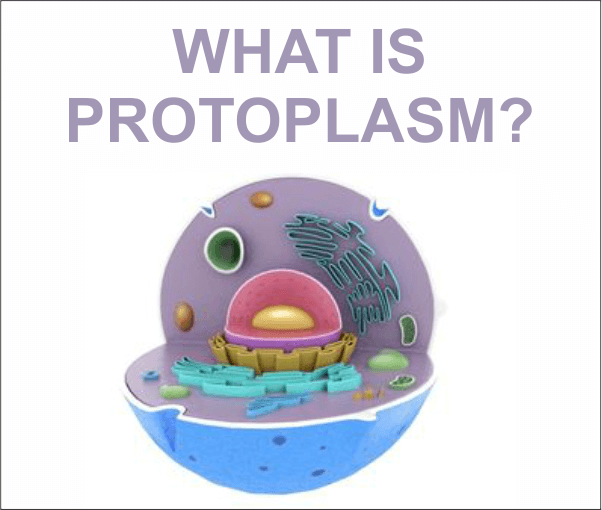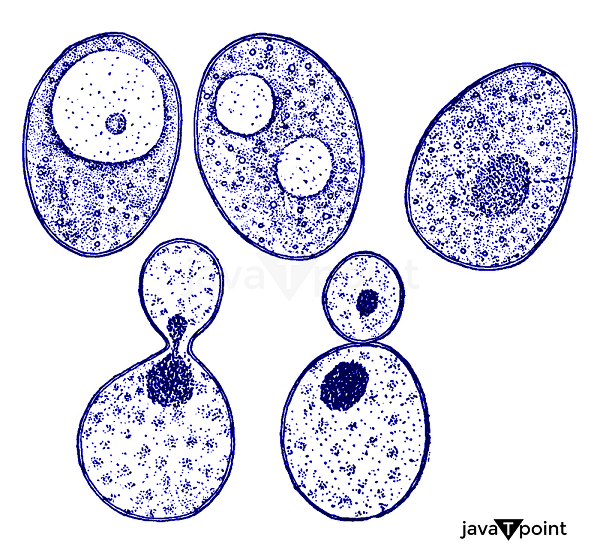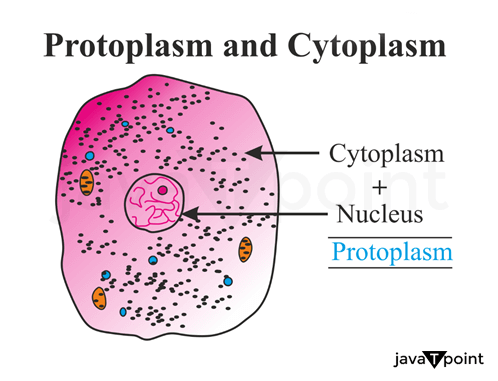Protoplasm DefinitionIntroductionThe living material inside cells is called protoplasm, and it has several distinctive qualities that allow it to perform the fundamental tasks of life. Protoplasm has several essential qualities, including self-regulation, and despite changes in the external environment, protoplasm can keep its internal environment steady. The life of the cell depends on this self-regulation. Overall, protoplasm is a dynamic and complex substance with various properties essential to the upkeep of life. 
Background History of ProtoplasmVon Mohl understood that protoplasm was a complex, dynamic substance that could perform all of the essential tasks for the cell. Other researchers expanded on protoplasm, such as the German biologist Rudolf Virchow, who postulated in 1855 that all cells originate from pre-existing cells. This hypothesis was eventually supported by the identification of DNA and the understanding of cell division. Modern biology owes much of its development to studying protoplasm, which is still an important topic of study today. The Chemical Makeup of ProtoplasmThe upkeep of life processes depends on the complex mixture of different chemical and inorganic substances that make up protoplasm. Protoplasm contains several important chemical elements as follows:

The Purpose of ProtoplasmThe living material inside cells is called protoplasm, and it performs various tasks crucial for the life and operation of the cell. Protoplasm serves several important purposes, including:
Protoplasmic StreamingNumerous types of cells, including plant, fungal, and certain animal cells, exhibit protoplasmic streaming. Organelles and other particles travel inside plant cells via protoplasmic streaming. This movement is crucial for the elimination of waste and the delivery of nutrients. Myosin motor proteins, which travel along actin filaments in the cytoplasm, cause protoplasmic streaming to move. Organelles and other particles move inside fungal cells via a process known as protoplasmic streaming. Dynein motor proteins, which travel along cytoplasmic microtubules, cause protoplasmic streaming to move in fungal cells. In some animal cells, specialized cells like muscle and amoeboid cells exhibit protoplasmic streaming. Protoplasmic streaming in muscle cells moves the muscle fibers and causes the muscle to contract. Protoplasmic streaming drives cellular motility and the engulfment of food particles in amoeboid cells. The microscopic, membrane-bound structures move chemicals around inside cells. The distribution of nutrients and elimination of waste materials within the cell depend on protoplasmic streaming. The dynamics and organization of protoplasm are intricate and dynamic processes essential to the healthy operation of cells. Overall, the study of protoplasmic streaming has revealed new information on the structure and operation of cells. It is a significant phenomenon in cell biology. The continual movement and activity of protoplasm within cells are called protoplasmic dynamics. Actin filaments and myosin motor proteins work together to propel the movement of protoplasm. Homeostasis and protoplasmic dynamics are crucial for preserving the well-being and functionality of cells. Numerous cellular disorders and diseases can result from these processes going wrong. Protoplasm and Cellular ProcessesNumerous cellular functions, such as cell development, division, metabolism, and signaling, are directly influenced by protoplasm. The following examples illustrate the role of protoplasm in these processes: Cell GrowthProtoplasm synthesizes new molecules and their incorporation into cells, which happens during cell proliferation. The coordinated action of several organelles, enzymes, and other substances within the protoplasm is necessary. Cell DivisionThe protoplasm divides the two daughter cells' genetic material and other biological components during cell division. The development of a sophisticated system of proteins and organelles is required for this process to separate the genetic material from the other cellular constituents accurately. Protoplasmic DifferentiationThe process by which undifferentiated cells specialize and acquire unique protoplasmic traits that allow them to carry out certain functions is known as protoplasmic differentiation. A complex multicellular organism's growth and maintenance depend on protoplasmic differentiation. Protoplasmic differentiation is a process in which cells modify their protein synthesis and gene expression to produce particular protoplasmic structures and activities. Growth factors, hormones, and chemicals in the extracellular matrix are signals that can cause differentiation. 
Protoplasmic EvolutionResearchers can create new methods for controlling cell fate and producing particular cell types for therapeutic purposes by comprehending the many signaling channels, transcription factors, and epigenetic variables involved in protoplasmic differentiation. Environmental pressures, like shifts in temperature, pH, and nutrition availability, have also influenced protoplasm's evolution. New cellular structures and functions evolved due to this process because organisms that could adapt to these changes had a higher chance of surviving and procreating. Over billions of years, many causes have impacted the evolution of protoplasm, making it a dynamic and complex process. The diversity of cellular processes, structures, and activities in protoplasm today ranges from the most basic bacterium to the most sophisticated multicellular creatures. Taxonomy and Protoplasmic DiversityThe diversity of protoplasmic forms present in living things is called protoplasmic diversity. These variations can be found in protoplasmic matter's structure, function, and chemical makeup. Protistology, or the scientific study of protists, encompasses the study of protoplasmic variety. Algae, protozoa, and slime moulds are examples of the varied group of eukaryotic organisms known as protozoa. These species are unique from plants, mammals, and fungi, although they are all connected by having a nucleus and other membrane-bound organelles. Protists demonstrate a broad spectrum of protoplasmic diversity, with various protist species having diverse traits and roles. For instance, certain protists can move around their surroundings thanks to distinctive features like flagella or cilia, while others have specialized organelles like chloroplasts that allow photosynthesis. Protist taxonomy is intricate and continually changing as researchers identify new protist species and improve their knowledge of how they interact with other living things. In the past, protists were categorized according to their cellular makeup and physical traits. Still, genomic sequencing has recently emerged as a crucial method for recognizing and categorizing protists. Overall, understanding the diversity and classification of protoplasm is essential for comprehending the biology and evolution of protists and the science of biology as a whole. Protoplasmic Communication and InteractionsFor cells and organisms to function properly, protoplasmic connections and communication are essential. Protoplasmic contacts within cells govern organelle mobility and the interchange of materials across various cell regions. The coordination of cellular functions and overall cellular homeostasis depends on cell-to-cell communication. Response of the Protoplasm to StimuliAs the living material inside cells, protoplasm responds differently to internal and exterior environmental stimuli. The survival and proper operation of cells and organisms depend on these reactions. Due to its dynamic nature and the availability of specialized cellular processes and signaling pathways, protoplasm can respond to stimuli. Chemical StimuliProtoplasm can react to chemicals by changing its cellular activity and going through biochemical processes. For instance, cells may adjust their metabolic pathways in response to particular chemicals or ions or release chemical signals to interact with other cells. Physical StimuliProtoplasm can also react to physical stimuli such as pressure changes, temperature changes, light, and mechanical forces. Specialized receptors and sensors in cells pick up these physical impulses, which set off the necessary reactions. Plants, for instance, can display tropic behaviors like bending towards a light source or growing downward. Electrical StimuliProtoplasm is susceptible to electrical stimulation as well. In nerve or muscle cells, action potentials are electrical signals that cells can produce and react to. These electrical signals enable quick communication, synchronization, and muscle contractions inside the neurological system. Hormonal StimuliHormones are chemical messengers secreted by cells or glands that can mediate protoplasmic reactions. Hormones can diffuse locally to target cells or move across the bloodstream to activate particular responses. Examples of hormonal reactions include metabolism regulation, growth and development, and maintenance of homeostasis. Environmental StimuliEnvironmental signals such as variations in light intensity, temperature, humidity, or nutrition availability frequently cause protoplasmic responses. Cells and organisms can adapt to changing environmental conditions thanks to these reactions. Complex cellular processes, such as modifications to gene expression, protein synthesis, cell signaling, and changes to membrane permeability, are all part of protoplasmic reactions to stimuli. These reactions are essential for preserving cellular homeostasis, orchestrating physiological processes, and allowing organisms to adjust to changing environments. Adaptation and Evolutionary ChangeProtoplasm's capacity to respond and adjust to environmental changes to survive and flourish is known as protoplasmic adaptation. Protoplasmic systems can change and adapt through adaptation, increasing their fitness and likelihood of survival in particular ecological situations. These adaptations can occur on a long-term, evolutionary timescale and a short-term, individual level. Short Term AdaptationProtoplasmic systems can make quick adjustments in response to sudden environmental changes. For instance, cells can modify their metabolic activities, adapt their membrane permeability, or activate stress response pathways to better resist unfavorable conditions when exposed to high temperatures or limited nutrition availability. Cells may survive thanks to these modifications until the stressor is gone or the situation improves. Long Term EvolutionProtoplasmic systems can experience genetic alterations over extended periods, resulting in more durable adaptations. These genetic alterations could result from several processes, such as natural selection, genetic recombination, and mutation. Protoplasmic systems with advantageous genetic differences, such as higher food intake, strengthened defenses, or better reproductive tactics, are more likely to survive and pass these favorable qualities on to succeeding generations. Natural selection is the method by which protoplasmic systems undergo evolution. It is more likely for protoplasmic features to be transmitted to the next generations if they give a selective advantage in a particular habitat. The population may exhibit more favorable qualities over time, resulting in the protoplasmic system adapting and evolving. Numerous organisms exhibit examples of protoplasmic adaptability and evolutionary change. One adaptation that enables increasing complexity and efficiency in carrying out certain duties is the development of specialized tissues and organs in multicellular organisms. Some protists and plants have evolved photosynthesis, allowing them to use solar energy and adapt to various settings. In conclusion, protoplasmic adaptation and evolutionary change are basic mechanisms that enable organisms to endure, procreate, and diversify in response to their environment. These mechanisms continue to drive the evolution of protoplasmic systems and have produced an astounding diversity of life on Earth. Phenotypic Variation and Protoplasmic PlasticityThe ability of protoplasm to alter its phenotype or properties in response to environmental stimuli or developmental signals is known as protoplasmic plasticity. It enables modifications in an organism's morphological, physiological, and behavioral features without affecting the genetic code that makes up its core. This plasticity significantly improves the adaptability and survival of organisms in various situations. The observable variations in attributes among individuals within a group are referred to as phenotypic variance. By enabling individuals to exhibit various phenotypes in response to environmental stimuli or situations, protoplasmic plasticity contributes to phenotypic variation. This variation can be irreversible, resulting in long-term changes in the phenotypic, or reversible, indicating that the phenotype can revert to its original state when the environmental conditions change. Protoplasmic plasticity can take several different forms: Morphological PlasticityIn reaction to environmental factors, organisms can modify their morphology and physical makeup. For instance, depending on the amount of light, nutrients, or water availability, some plants can change their root structure, stem length, leaf shape, or size. Physiological PlasticityProtoplasmic systems can modify their physiological processes to enhance performance in various situations. This may involve modifications in metabolic rate, enzyme activity, or hormone synthesis in response to environmental signals. Animals may, for instance, alter their metabolic rate, heart rate, or capacity for water retention in reaction to temperature changes or food availability. Behavioral PlasticityProtoplasmic plasticity is also visible in how organisms react behaviourally. Depending on the environment or social interactions, animals might alter their behavior, including foraging tactics, mate choices, or predator avoidance. Developmental PlasticityIndividual differences in phenotype can be brought on by developmental protoplasmic plasticity. Environmental variables can affect gene expression during crucial developmental times, changing the phenotypic permanently. This can be seen in creatures with complex life cycles, such as insects that go through metamorphosis or plants that display many growth forms depending on the availability of nutrients. Phenotypic diversity and protoplasmic plasticity allow organisms to adapt to shifting environmental conditions and maximize their chances of survival and reproduction. To better adapt to their environment and achieve ecological success, organisms can modify their phenotype to meet those requirements. Protoplasmic Disorders and Pathologies
Next TopicProvision Definition
|
 For Videos Join Our Youtube Channel: Join Now
For Videos Join Our Youtube Channel: Join Now
Feedback
- Send your Feedback to [email protected]
Help Others, Please Share










